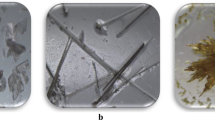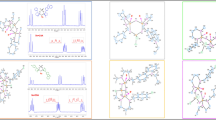Abstract
Three tripod molecules, tris(2-methoxy-5-nitrobenzyl)phosphine oxide (1), tris(2-butoxy-3-methyl-5-nitrobenzyl)phosphine oxide (2), and tris(3-nitrobenzyl)amine (TNBA), were synthesized and crystallized. The structures of 1, 2, and their comparison (TNBA) were determined by X-ray crystallography. It is noteworthy that compound 1 interacted with adjacent molecules via π-π stacking and C-H⋯π interactions to yield an open supramolecular network with the porosity P in 8.9%, whereas compound 2 gathered closely to form an open-dimer capsule by sixfold N-O⋯π and triple C-H⋯O interactions, which showed a rare example of a stable in, out-invertomer of phosphine inversion existing in open-dimers. A series of columns were built and arranged side by side by these weak interactions. By contrast, TNBA crystallized to form a 2D network maintained by C-H⋯O and C-H⋯π interactions. It seems minor changes of the chemical structure may cause large differences in the crystal structure and interactions in crystal engineering.
Similar content being viewed by others
References
Basavoju S, Aitipamula S, Desiraju GR. Host-guest and network structures of some tetraphenylmethane derivatives. CrystEngComm, 2004, 6(25): 120–125
Bai ZS, Chen SS, Zhang ZH, Chen MS, Liu GX, Sun WY. Two novel interpenetrated zinc(II) and cadmium(II) coordination polymers based on 4-imidazole-benzoate: Syntheses, crystal structures and properties. Sci China Ser B: Chem, 2009, 52(4): 459–464
Ou GC, Jiang L, Feng XL, Lu TB. Synthesis and structures of two supramolecular complexes constructed via hydrogen bond linking. Sci China Ser B: Chem, 2009, 52(4): 465–470
Li X, Li H, Yu SY, Li YZ. Anion coordination complex [ClÌPt-(bpt)4]Cl (bpt=N,N′-bis(3-pyridylmethyl)-2-thiourea). Sci China Ser B: Chem, 2009, 52(4): 471–474
Xiao X, Zhang YQ, Zhu QJ, Xue SF, Tao Z. Host-guest complexes of a water soluble cucurbit[6]uril derivative with some dications of 1, ω-alkyldipyridines: 1H NMR and X-ray structures. Sci China Ser B: Chem, 2009, 52(4): 475–482
Laliberté D, Maris T, Wuest JD. Molecular networks built from weakly interacting nitro-substituted pentaerythrityl tetraaryl ethers. CrystEngComm, 2005, 7(24): 158–160
Huang LL, Massa L, Karle J. Calculated interactions of a nitro group with aromatic rings of crystalline picryl bromide. Proc Natl Acad Sci USA, 2008, 105: 13720–13723
Desiraju GR. The C-H⋯O Hydrogen Bond: Structural Implications and Supramolecular Design. Acc Chem Res, 1996, 29: 441–449
Sutor DJ. Evidence for the existence of C-H⋯O hydrogen bonds in crystals. J Chem Soc, 1963, 1105–1110
Houk KN, Menzer S, Newton SP, Raymo FM, Stoddart JF, Williams DJ. [C-H⋯O] Interactions as a control element in supramolecular complexes: experimental and theoretical evaluation of receptor affinities for the binding of bipyridinium-based guests by catenated hosts. J Am Chem Soc, 1999, 121: 1479–1487
Raymo FM, Bartberger MD, Houk KN, Stoddart JF. The magnitude of [C-H⋯O] hydrogen bonding in molecular and supramolecular assembles. J Am Chem Soc, 2001, 123: 9264–9267
Thaimattam R, Feng X, Sarma JARP, Mak TCW, Desiraju GR. Inclusion compounds of tetrakis(4-nitrophenyl)methane: C-H⋯O networks, pseudopolymorphism, and structural transformations. J Am Chem Soc, 2001, 123: 4432–4445
Braga D, Grepioni F, Novoa JJ, Inter-anion C-H⋯O hydrogen bond like interactions: the breakdown of the strength-length analogy. Chem Commun, 1998, 1959–1960
Macchi P, Iversen BB, Sironi A, Chakoumakos BC, Larsen FK. Interanionic O-H⋯O interactions: The charge density point of view. Angew Chem Int Ed, 2000, 39: 2719–2722
Madhavi NNL, Katz AK, Carrell HL, Nangia A, Desiraju GR. Evidence for the characterisation of the C-H⋯π interaction as a weak hydrogen bond: toluene and chlorobenzene solvates of 2,3,7,8-tetraphenyl-1,9,10-anthyridine. Chem Commun, 1997, 1953–1954
Biradha K, Zaworotko MJ. A Supramolecular analogue of cyclohexane sustained by aromatic C-H⋯π interactions: Complexes of 1,3,5-trihydroxybenzene with substituted pyridines. J Am Chem Soc, 1998, 120: 6431–6432
Lindeman SV, Kosynkin D, Kochi JK. Unusually short (C-H⋯π) hydrogen bonds for effective supramolecular (aromatic/aromatic) organization in edge-to-face motifs. J Am Chem Soc, 1998, 120: 13268–13269
Harder S. Can C-H⋯C(π) bonding be classified as hydrogen bonding? A systematic investigation of C-H⋯C(π) bonding to cyclopentadienyl anions. Chem Eur J, 1999, 5: 1852–1861
Desiraju GR. Hydrogen bridges in crystal engineering: interactions without borders. Acc Chem Res, 2002, 35: 565–573
Desiraju GR, Steiner T. The Weak Hydrogen Bond in Structural Chemistry and Biology. Oxford: Oxford University Press, 1999
Hunter CA, Lawson KR, Perkins J, Urch CJ. Aromatic interactions. J Chem Soc, Perkin Trans 2. 2001, 651–669
Demers E, Maris T, Cabana J, Fournier JH, Wuest JD. Weakly bonded molecular networks built from tetranitro- and tetracyanospirobifluorenes. Cryst Growth Des, 2005, 5(3): 1237–1245
SMART, version 5. Madison, Wisconsin: Bruker AXS Inc. 2002
Sheldrick GM. SADABS, Program for Empirical Absorption Correction of Area Detector Data. University of Gottingen, Göttingen, Germany, 1996
Sheldrick GM. A short history of SHELX. Acta Cryst, 2008, A64: 112–122
The percentage of volume accessible to guests was estimated by the PLATON program. See: Spek AL. PLATON, A Multipurpose Crystallographic Tool. Utrecht, the Netherlands: Utrecht University, 2001. van der Sluis P, Spek AL. BYPASS: an effective method for the refinement of crystal structures containing disordered solvent regions. Acta Cryst, 1990, A46: 194–201
Alder RW, Butts CP, Orpen AG, Read D. J Chem Soc, Perkin Trans 2, 2001, 288–295
Friedrichsen BP, Whitlock HW. Concave functionality: Intracavity phosphine oxide as a locus of complexation. J Am Chem Soc, 1989, 111: 9132–9134
Friedrichsen BP, Powell DR, Whitlock HW. Sterically encumbered functional groups: An investigation of endo versus exo phosphoryl complexation using 1H and 31P NMR. J Am Chem Soc, 1990, 112: 8931–8941
Author information
Authors and Affiliations
Corresponding authors
Additional information
This work was supported by the National Natural Science Foundation of China (Grant Nos. 20602017 & 20932004), the National Basic Research Program of China (Grant No. 2007CB925103), and the Natural Science Foundation of Jiangsu (Grant No. BK2008259).
Rights and permissions
About this article
Cite this article
Han, J., Deng, C., Fang, R. et al. Tripod molecules build molecular networks and open-dimer capsules by weak interactions. Sci. China Chem. 53, 851–857 (2010). https://doi.org/10.1007/s11426-010-0119-7
Received:
Accepted:
Published:
Issue Date:
DOI: https://doi.org/10.1007/s11426-010-0119-7




